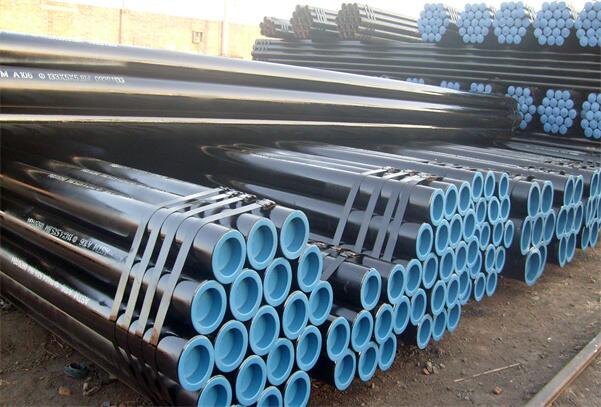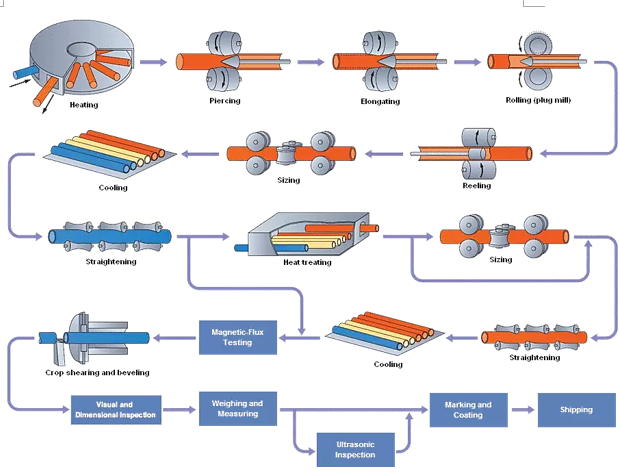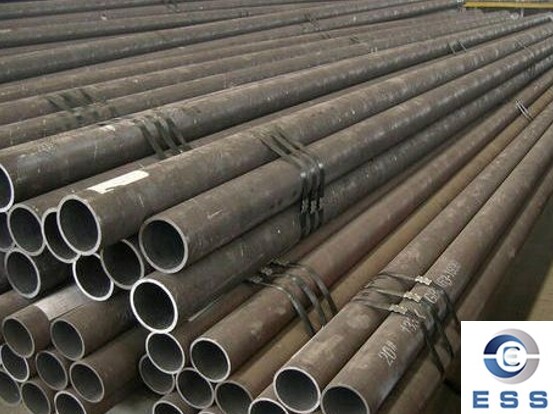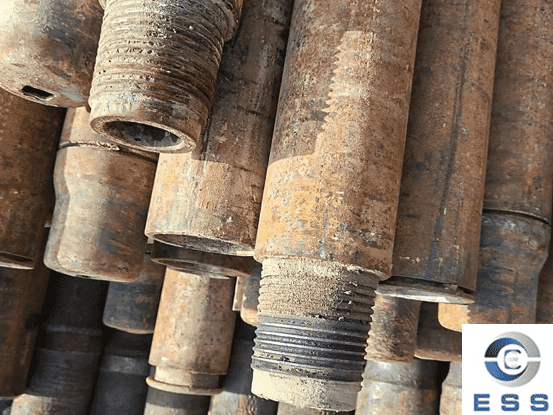Seamless pipe is a steel pipe variant
manufactured without any welded joints, hence the name. Seamless pipe has no
seams, reducing the risk of fracture under high pressure and stress. Unlike
welded pipe, seamless pipe has a smoother surface and more uniform diameter.
These characteristics give it exceptional
durability and corrosion resistance. All of these exceptional qualities make it
an ideal choice for the oil and gas industry and the construction industry.

Core Processes of Seamless Steel Pipe
Seamless pipe production begins with a
solid round billet. After being heated to a high temperature, the billet is
rolled into a hollow shell through a piercing mill. This is then rolled through
multiple passes, sizing, and heat treatment to achieve seamless pipes that meet
dimensional and performance requirements.
Core Processes Include:
1. Piercing
Rolling the hot billet into a hollow shell
is the key process that distinguishes seamless pipe from seam
pipe.
2. Rolling and Elongation
The shell is extended through a continuous
rolling mill or a pipe jacking mill to control the outer diameter and wall
thickness.
3. Sizing/Reducing
Further adjusts the pipe diameter to ensure
precise geometric dimensions.
4. Heat Treatment
Improve microstructure and properties,
enhancing toughness, ductility, and corrosion resistance.

Detailed Production Process of Seamless
Pipe
1. Raw Material Selection
Seamless pipe is a durable option for a
wide range of applications. However, to maximize its versatility, it must offer
a variety of processing materials. Raw material selection is key to achieving
the desired pipe properties, including tensile strength, yield strength, and
hardness.
The following are the most commonly used
materials for seamless pipe manufacturing:
Carbon Steel
Commonly used for general-purpose piping,
it offers good strength and weldability. It is suitable for low-pressure
applications such as water, gas, and cryogenic systems.
Alloy Steel
Composed of alloying elements such as
chromium, nickel, and molybdenum. This composition provides increased strength,
toughness, heat resistance, and corrosion resistance.
Stainless Steel
Ensures excellent corrosion resistance and
toughness. It is commonly used in corrosive environments such as marine and
chemical processing.
2. Heating
The steel billet is heated to a high
temperature of 1150°C to 1250°C
to achieve a ductile state. Temperature control is crucial; too low a
temperature can make piercing difficult, while too high a temperature can cause
coarse grains.
3. Extrusion
Industrial rotating tools penetrate the hot
billet, forming a hollow tube shell. The drawing process passes the shell
through a series of heavy rollers, ultimately forming the desired initial shape
and dimensions for the pipe.
4. Expanding
During the expansion process, workers
continuously press a mandrel into the tube. This step is crucial for ensuring a
smooth inner diameter and uniform wall thickness. Mandrel milling involves
continuous rolling and drawing until the desired dimensions are reached.
5. Cooling
The rolled tube billet is cooled in a
controlled environment to prevent cracking caused by thermal stress. Air
cooling or controlled cooling is often used to maintain uniform microstructure.
6. Straightening
Even after cooling, the pipe will still
deform and bend. Therefore, the pipe still needs to pass through rollers or
straighteners to apply controlled pressure to align the pipe. This ensures the
geometric accuracy and usability of the final seamless pipe.
7. Post-Processing
Post-processing may include surface
polishing, threading, or heat treatment to enhance pipe performance. Workers
may also add surface coatings to prevent wear and corrosion.
8. Quality Control
The quality control department inspects
pipes for dimensional accuracy, strength, and surface defects. Safety
inspection mechanisms, including X-ray and ultrasonic testing, ensure the pipes
are free of defects. Pipes undergo final inspection before shipment.
Seamless Steel Pipe Production Craftsmanship
Generally, seamless steel pipe production
processes are divided into cold rolling and hot rolling.
Main production processes (main inspection
processes) for hot-rolled seamless steel pipe:
Pipe Preparation and Inspection → Pipe Heating → Pipe Piercing → Pipe Rolling → Rough Pipe Reheating → Sizing (Reducing) → Heat Treatment → Finished Pipe Straightening → Finishing → Inspection (Non-destructive, Physical and Chemical, Benchtop
Inspection) → Warehousing
Hot-rolled seamless steel pipes are
generally delivered in the hot-rolled state after heat treatment. Hot-rolled
seamless steel pipes undergo rigorous manual selection after quality
inspection. The surface is then oiled and subjected to multiple cold-drawing
tests. After hot-rolling, a perforation test is performed. If the perforation
is too large, the pipes are straightened. After straightening, they are
conveyed by conveyor to a flaw detector for testing. Finally, they are labeled,
sorted according to specifications, and stored.
The main production process for cold-rolled
(drawn) seamless steel pipes is as follows:
Blank preparation → Pickling and lubrication → Cold rolling (drawing) → Heat treatment → Straightening → Finishing → Inspection
The production process for cold-rolled
seamless steel pipes is generally more complex than that for hot-rolled pipes.
If no reaction cracks are observed on the surface during the sizing test, the
round pipe is cut using a cutting machine into blanks approximately one meter
in length. Annealing is then performed, followed by pickling with acid. During
pickling, pay attention to any significant blistering on the surface. If
significant blistering is present, the pipe quality does not meet reaction
standards.
In appearance, cold-rolled seamless steel
pipes are shorter than hot-rolled seamless steel pipes. The wall thickness of
cold-rolled seamless steel pipes is generally thinner than that of hot-rolled
seamless steel pipes. However, the surface of cold-rolled seamless steel pipes
appears much shinier than thick-walled seamless steel pipes, with less
roughness and fewer burrs on the diameter.
Hot-Rolled Seamless Steel Pipe VS.
Cold-Rolled Seamless Steel Pipe
|
Property
|
Hot-Rolled Seamless Pipe
|
Cold-Rolled Seamless Pipe
|
|
Manufacturing Temperature
|
Produced at high temperatures
(>1,000°C)
|
Produced at room temperature or slightly
elevated
|
|
Surface Finish
|
Rough, may have scale
|
Smooth, clean surface, minimal oxidation
|
|
Strength
|
Lower tensile strength and hardness
|
Higher tensile strength, more precise
dimensions
|
|
Cost
|
Less expensive
|
More expensive due to additional
processing
|
|
Applications
|
Heavy-duty, low-precision uses
|
Precision engineering, automotive,
aerospace, pressure vessels
|
Summary
In summary, the production of seamless
steel pipes is a highly sophisticated and complex process, requiring the
coordinated efforts of multiple steps and quality control measures. By strictly
controlling raw material quality, optimizing piercing and rolling processes,
rationally selecting heat treatment methods and finishing processes, and
implementing rigorous inspection and control measures, we can produce
high-quality seamless steel pipes that meet the needs of various industrial
sectors.
Read more: ST52 seamless steel pipe or Seamless steel pipe sizes













 Eastern Steel Manufacturing Co.,Ltd not only improve product production and sales services, but also provide additional value-added services. As long as you need, we can complete your specific needs together.
Eastern Steel Manufacturing Co.,Ltd not only improve product production and sales services, but also provide additional value-added services. As long as you need, we can complete your specific needs together.











